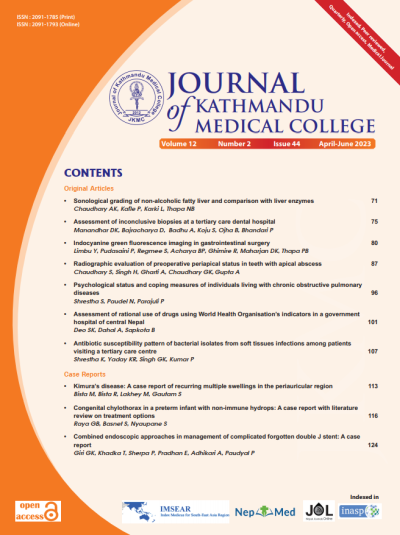Antibiotic susceptibility pattern of bacterial isolates from soft tissues infections among patients visiting a tertiary care centre
DOI:
https://doi.org/10.3126/jkmc.v12i2.60346Keywords:
Antibiotic, Pus, Staphylococcus aureusAbstract
Background: Pus is a thick, white to yellow fluid that consists of dead leucocytes, cellular debris, necrotic tissues, and bacteria characteristic of pyogenic infections that may be exogenous or endogenous. The resistant pathogens isolated from wound infections have become a global challenge and a grave threat to the public health worldwide.
Objectives: To characterise the bacterial isolates from clinical specimens of pyogenic wound infections and to determine the antibiotic susceptibility test.
Methods: A hospital-based, descriptive, cross-sectional study was carried out after ethical clearance in the department of microbiology, Nobel Medical College from 2021 May to 2022 January. Various clinical specimens were obtained by convenience sampling. Identification and antibiotic sensitivity test were done as per the standard microbiological procedures. Data were analysed by SPSS v.20.
Results: Out of 1704 sample collected, 901 (52.8%) showed growth in which 893 (52.4%) showed monomicrobial growth and 8 (0.46%) showed mixed growth. Among the samples, females outnumbered males (F: M-1.4:1) and majority of infection were observed in age group between 21-30 years. Most of the isolates were Gram-negative bacteria (462, 50.8%) which were mostly sensitive to amikacin. The most predominant organism was Staphylococcus aureus (427, 47%) which was 100% sensitive to vancomycin and highly resistant to ampicillin (341, 79.8%).
Conclusion: The dryness in the pipeline of new antibiotic and emergence of multidrug resistant strains have pointed the current need towards active microbial surveillance in all clinical settings and prudent use of antibiotics.
Downloads
Downloads
Published
How to Cite
Issue
Section
License

This work is licensed under a Creative Commons Attribution-NonCommercial 4.0 International License.
Copyright © Journal of Kathmandu Medical College
The ideas and opinions expressed by authors or articles summarized, quoted, or published in full text in this journal represent only the opinions of the authors and do not necessarily reflect the official policy of Journal of Kathmandu Medical College or the institute with which the author(s) is/are affiliated, unless so specified.
Authors convey all copyright ownership, including any and all rights incidental thereto, exclusively to JKMC, in the event that such work is published by JKMC. JKMC shall own the work, including 1) copyright; 2) the right to grant permission to republish the article in whole or in part, with or without fee; 3) the right to produce preprints or reprints and translate into languages other than English for sale or free distribution; and 4) the right to republish the work in a collection of articles in any other mechanical or electronic format.




